Blue Nose Pitbull Dog Breed Temperament Diet and Training
The Blue Nose Pitbull looks frightening. But don’t let its intimidating looks deceive you.
If you raise this muscular fellow well, he will make a gentle, sociable pet. Do note that it isn’t for you if you live in an apartment complex because it looks somewhat tough and scary. Here’s some advice on how to make it the perfect pet.

1. What is the Blue Nose Pitbull?
You may be familiar with this tough guy, but some facts may elude you. We introduce you to what the Blue Pitbull is, and other fascinating details about it.
First of all, some of these dogs don’t have blue noses, despite being called Blue-Nose Pitbulls. Blue Nose Pitbull kennels may not produce dogs with blue snouts. Regardless of their conformation, people consider them Blue Pitbulls.
a. The Blue Pitbull is not a distinct pitbull breed
Blue Pitbulls aren’t offspring from different Pitbulls or a separate class of them. This fellow is an American Pitbull Terrier which has a blue nose. It shares a bloodline with other Pitbulls.
b. This dog has a bad reputation
Many people think that this dog is dangerous. Some governments have banned it in their countries.
But why does it have such a bad reputation? Breeders used it for blood sport. As such, ill-bred ones tend to have a strong fighting instinct. Early socialization keeps this tendency in check.
c. It has lots of energy
Don’t consider welcoming this dog into your home if you don’t lead an active lifestyle. The Blue Pitbull needs plenty of physical and mental stimulation. Take it to dog runs or walks around the park.
d. Blue Pitbulls have human emotions.
Blue Pitbulls love their friends, just as humans do. They enjoy bonding with the people and pets in the home. They can get emotional and display stubborn behavior.
e. Blue Pitbulls make excellent family pets
It may look intimidating, but the Blue Pitbull makes a first-class family pet. Children tend to hug pets too hard or play too roughly with them. While other dogs may growl or lose their patience, the Blue Pitbull will willingly tolerate the rough play. That aside, do supervise your children when they are around the dog.
f. The Blue Pitbull is intelligent
The Blue Pitbull may come off as a little goofy but is smart. It responds to instructions quickly and is surprisingly easy to potty train.
g. The Blue Pitbull isn’t a good watchdog
Ferocious as it looks, the Blue Pitbull isn’t protective of its human. In fact, it can be a little too friendly with strangers. If you are hoping that it will take a good bite out of a trespasser, you may be disappointed.
h. The Blue Pitbull jumps
The Blue Pitbull excels at agility and circuit training. Hefty as it seems, it can sail through the air. Expect it to spring up at you when you return home from a long day at work.
i. The Blue Pitbull sweats heavily
Exercising can cause this fellow to perspire. Therefore, you’ll find that it takes to water quickly.
2. Blue Nose Pitbull history
a. Breed History
Pitbulls are a cross between terriers and bulldogs. Breeders wanted to combine the gameness of the terrier with the bulldog’s strength. Ratting, which involves putting dogs in a pit, led to the name ‘Pitbull.’
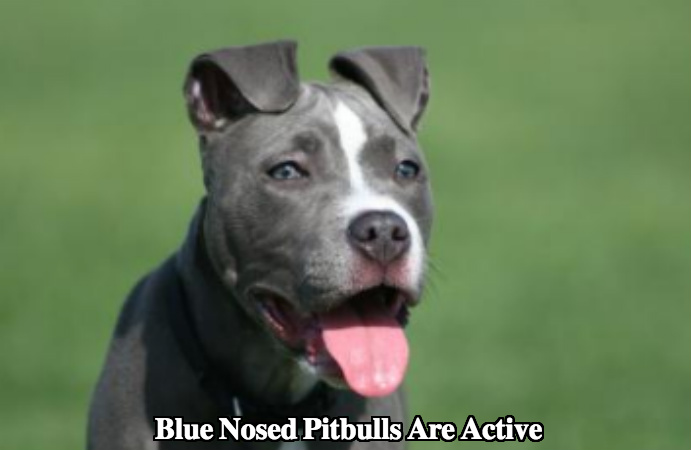
People in the United Kingdom used them in blood sports in years past. Mercenaries used them to fight bulls and bears. 1835 saw the elimination of such activities.
They came to America in the 20th century, where farmers used them to herd cattle and drive livestock. Hustlers in the United States train them in illegal dog fights today. They serve as guard dogs for illicit narcotics operations. Law enforcement seeks to stop such abuse.
The San Francisco Society for the Prevention of Cruelty to Animals renamed Pitbull Terriers to San Francisco Terriers in 1996. It had the aim of encouraging adoption. The program ceased after some of the dogs killed cats. The New York City Center had a similar purpose and renamed these dogs ‘New Yorkies’ in 2004. The center gave up the idea in the face of public opposition.
The Federation Cynologique Internationale only recognizes three Pitbull strains – the Bull Terrier, the Staffordshire Terrier, and the Minature Bull Terrier. The Blue Pitbull is technically a crossbreed which has become well-received in recent years.
The United Kennel Club recognizes the breed. According to its standards, it has large, wide open nostrils. It also acknowledges American Staffordshire Terriers, which they see as synonymous with Blue-Nosed Pitbulls. To them, the Staffordshire’s, and hence Blue Pitbull’s nose should be black.
b. Genetic Research
The Blue Nosed Pitbull has a relatively short history. The American Kennel Club reflects that there isn’t much genetic research on the breed.
However, Pitbulls with red and blue noses have become fashionable. The blue pigment in their noses is a result of homozygous recessive gene mutation or the dilating of the black nose color. The blue color can lead to blue health issues.
c. Famous Pitbulls
This dog’s unflinching demeanor makes it an ideal police dog. It has an innate cuteness, which has turned it into a television personality as well. Writer Helen Keller overcame multiple disabilities with the help of her dog, Sir Thomas. American President Theodore Roosevelt had a Pitbull named Pete, while Sergeant Stubby, a gutsy Pitbull, served in the 102nd infantry in World War 1.
Pitbulls have indomitable courage. Weebla helped save 32 people, 29 dogs, three horses and one cat during the widespread flooding in California in 1993. Popsicle, whose owners found him nearly dead in a freezer, became an indispensable police dog in the United States. Lily lost her leg after trying to pull its owner from underneath train tracks. D-boy took three bullets while trying to save its family from being shot.
They also have remarkable intuitiveness. The Purina Hall of Fame inducted Norton for rescuing its owner after he got bitten by a spider. Titan saved its owner’s wife after an aneurysm overcame her.
Perhaps the most famous Pitbull in recent time is Daddy, the Pitbull which belonged to Dog Whisperer Cesar Millan. It was famous for having a mellow temperament. It also showed calmness in front of ill-mannered dogs.
3. Choosing a Blue Nose Pitbull
A puppy isn’t a purchase, but a family member. Choosing one that suits your lifestyle is essential. Here are a few tips that will assist you with the process.
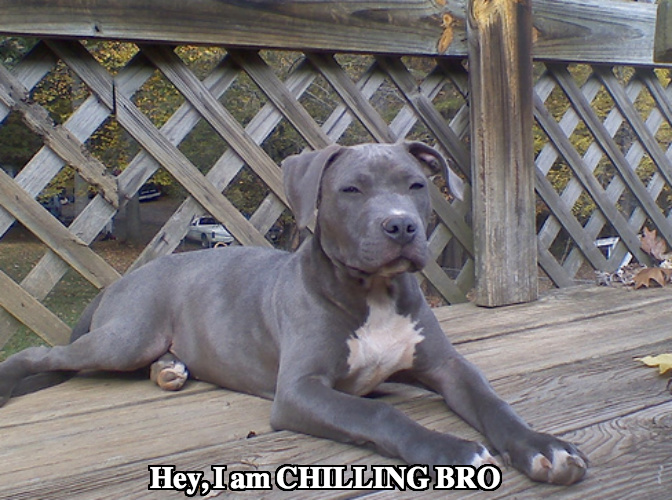
a. Choose the right breeder
The first step in choosing the right Blue Pitbull puppy is to select the right breeder.
Never buy puppies from puppy mills, Blue Pitbulls or otherwise. Many puppy mills breed their dogs in unsanitary conditions. The puppies come into this world with injuries and illnesses. Some of them walk around with permanent limps.
The breeder should always house his dogs in spacious, clean conditions. He should have whelping supplies ready, and be willing to let you meet the puppies he sells. He should allow you to meet their parents, and inform you if they have behavioral or medical conditions.
b. Breed
Also, you’ll have to consider if the Blue Pitbull is the right dog breed for you. You will have to socialize it early to prevent aggression issues; note that Pitbulls only become temperamental when not socialized. Remember that this dog isn’t sedentary; If it’s a quiet lapdog you’re after, the Pitbull isn’t for you.
Know the breed standard as well. A Pitbull has lean, well-defined bodies and muscles. It should never be petite or have delicate bones. Its body is slightly longer than its tail. Its legs should take up about half its height. It is medium-sized.
c. Meet the parents
Take some time to get to know the puppy’s mother and father. Both should be in the pink of health and have no behavioral issues; remember to ask the breeder about them. Puppies may inherit them from their parents.
d. Meet the puppies as a litter
Then, its time to meet the puppies. Meet with the litter as a whole. Dominant puppies will scramble to be first in line for their mothers’ milk, while timid or submissive ones will let them have their way. Choose a puppy that fits your personality.
e. Meet the puppies individually
Once you’ve decided on the puppy that you like, handle it. Cradle and lift it. The more responsive it is to handling, the better.
Watch out for physical weaknesses as well. Puppies should be round and healthy. They should have wet noses and pink tongues. They should be eager to eat; not eating is a sign of illness. A puppy shouldn’t cough more than once throughout your visit. Bloody stools should ring alarm bells.
Note that a puppy may behave differently on its own than with its littermates. Timid puppies may become more outgoing when they are by themselves. The reverse is also true; outgoing ones may be shy when they are alone.
f. Puppy or senior dog
All pets deserve a home. Puppies bring joy; it’s a blessing to see them grow under your care.
That said, there are many advantages to owning a senior Blue Pitbull. It wouldn’t need as much time to house train and will be able to respond to your instructions faster than a puppy.
4. House training a Blue Nose Pitbull
House training any dog is a challenge. The good news is that you won’t have to plow through the process with the Blue Pitbull.
This fellow is responsive and a joy to train. Here are a few tips that will take you through the process.
Potty training a puppy can be overwhelming, especially if you’re new to the process. Familiarize yourself with the basics.
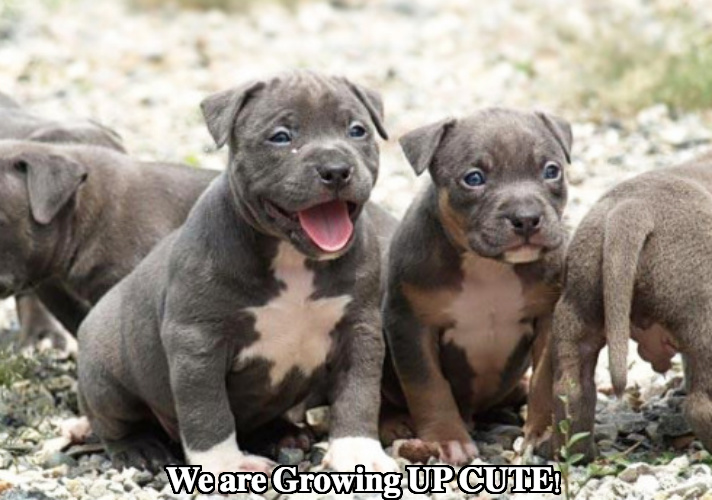
a. Routines
First, it’s essential to set up a potty routine for your Blue Pitbull. A schedule will remind it that it’s time to go.
Puppies usually ease themselves after they get up for the day, after they eat, and before they go to bed. Take your Blue Pitbull out at these times.
Whether you’re training your dog in or outdoors, make sure it eliminates in the same spot. The scent will remind it that it should relieve itself there.
b. Crate Training
Crates may seem offensive and restrictive, but they are essential for keeping your pet safe in cars or public places. They are useful potty training tools.
A crate is your Pitbull’s home; your pet will make that association and understand that it is not a toilet. Make sure that it is big enough for your dog to turn, sit, and lie down. If it’s too big, your pet will choose a corner where it will eliminate.
Encourage your Pitbull to use it by leaving the door open and putting a treat in it. Don’t close the door; you want your dog to feel that it’s a home and not a prison. It will go in on its own if the setting is comfortable.
c. Paper training
Paper training is essential if you live in an apartment. Your Pitbull will have to ease itself indoors if there aren’t many outdoor spaces.
Fence up a small area using a puppy pen. Lay newspaper in it, and put your Pitbull there at the appointed potty times.
Remove some of the paper as your pet becomes used to easing itself in the area. You will be able to limit the space where it can go.
d. Bells
Bells remind your Pitbull Puppy that it’s time to ease itself. Get it to ring the bell with its paws at the appropriate times.
Hang one over the door of your crate and another over the dog door. Your pet will ring the bells to inform you that it’s potty time.
5. Blue Nose Pitbull appearance
The Blue Pitbull stands out because its nose and fur have a bluish-gray hue. Appearances can be deceiving with this breed, and you will understand why.
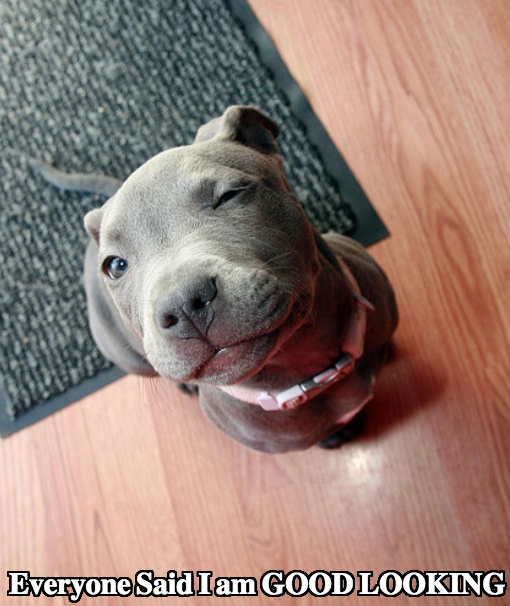
a. Size
On the surface, the Blue Pitbull appears to be an average, medium-sized breed. However, there is more to it than meets the eye, literally.
It appears to weigh between 30 to 50 pounds, like other medium-sized breeds. In fact, it can be as massive as 85 pounds.
b. Demeanor
The Blue Pitbull has sturdy legs, a broad chest, and a confident stance. It can make any dog who looks at it feel small.
However, it may not have an Alpha personality. Like Ceasar Millan’s Daddy, it is well-behaved around other people and pets. The only reason for its poor reputation was that breeders nurtured it for blood sports in days of old.
c. Eye Color
The eyes of a blue Pitbull are usually brown or hazel.
d. Nose
The outstanding trait of this breed is its nose. This dog hails from a somewhat rare genetic pool. The blue color of its snout is the result of color dilution. This color may sometimes result in unwanted health issues.
e. Coat
Another outstanding trait of this breed is its blue-gray coat. The hairs are short, soft and silky. They need regular brushing with a slicker brush.
6. Grooming a Blue Nose Pitbull
Grooming requires patience and effort. It can be especially taxing if the dog, like the Poodle, needs a stylized cut. Thankfully, grooming the Blue Pitbull doesn’t involve excessive stress. You do, however, need to understand its needs.
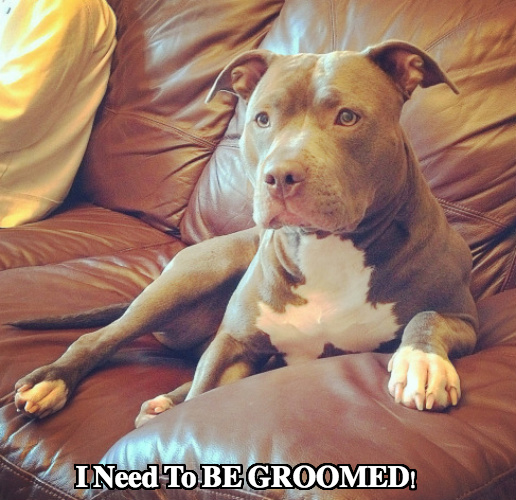
a. Brushing
Brushing your dog’s hair prevents shedding and skin issues. It also removes pet dander, which may trigger allergies. The Pitbull has a short, silky coat that sheds on occasion. Brushing it with a slicker brush will reduce the shedding.
b. Clipping
Of course, this handsome fellow requires only occasional clipping. Use a clipper with a fine-toothed blade.
c. Bathing
Blue Pitbulls love being clean. Thankfully, it’s a wash-and-wear dog. You can bathe it as often as you need.
If your dog is new to the household, assert yourself and let it know that you’re in charge of the bath situation. It’s best to get the dog used to baths when they are young.
Your Pitbull may feel uncomfortable in a bath situation. Take it for a long walk before bathtime to tire it out; dogs are more amenable when they are exhausted.
Coax it into the tub with a treat. Ask your vet for recommendations should your pet have skin issues.
Protect your pet’s eyes as water may irritate the membranes in them. Avoid spraying water directly on its head.
Massage the shampoo from its head to its tail. Bath brushes help to distribute the shampoo evenly. Rinse the shampoo off thoroughly. Dry your Pitbull with a towel, and reward it.
d. Nail Clipping
Clipping a dog’s nails can be challenging, especially if your pet hasn’t experienced the process before. You may want the assistance of a professional groomer.
Cutting into the quick can cause profuse bleeding. If you’re doing the clipping yourself, start by massaging your pet’s paws. Let it get used to being handled. Then, proceed with the cutting; don’t cut off too much of the nails at once. You can do more as your pet gets used to the process.
e. Ear Cleaning
Dab a little ear-cleaning solution onto a cotton swab and fold your pet’s ears back. Clean the outer ear.
Then, proceed to clean the inner ear. Make sure that water doesn’t get into the ear during the process.
f. Begin from within
A Pitbull has a short coat that looks beautiful when its shiny. Proper nutrition gives it this glow.
Feed your pet a top-quality diet that’s rich in nutrients. Dogs need lots of Vitamin E, Omega-3, and Omega-6 to grow glossy coats. Cooked eggs are a rich protein source.
Commercial food is high in these nutrients, so it’s possible to find the right balance. However, this may be a challenge as your pet ages. It may not be able to metabolize food as quickly and may gain weight. Weight gain makes for a dull coat.
7. Blue Nose Pitbull Temperament
The governments of some countries have banned Pitbulls from residential areas, owing to their reputation for aggression.
You may be considering giving one home, but its temperament concerns you. So, does it deserve negative reviews? Here are some Blue Pitbull traits you may want to bear in mind.
a. Active
First, don’t consider owning one unless you love the outdoors. The Blue, like its Pitbull cousins, is an active fellow. Don’t dream of housing it in an apartment because it will become cranky; it craves space.
A Pitbull becomes bored without exercise. It may also become destructive. Keep it inside for a long time, and say goodbye to your favorite slippers.
b. Confident
The Blue has an alpha personality, much like other Pitbulls. It carries itself with a confident demeanor and walks with a spring in its step. It has an impressive, intimidating presence.
So self-assured are some Blues that many of them have an alpha dog personality. They set boundaries and are territorial at times.
Remind your Blue of its place. Get it to remember that you are its owner and hence, the ‘alpha’ in the relationship.
c. Loyal and Loving
That said, most Blues are sweethearts and ultimate family pets. As shared earlier, many have risked their lives to rescue their family members from dangerous circumstances. They want involvement in all family activities, so don’t be surprised if you find yours tumbling around with your kids when its playtime.
d. Aggression
This quality is the one that worries most Pitbull owners. So, is Pitbull aggressiveness real, or a myth?
It is, to some extent. Breeders crossed bulldogs with terriers in the hope of creating ultimate fighting dogs. Pitbulls took part in blood sports, and many fought to the death. Some breeders deliberately enhanced their fighting qualities, and still, do. Many take part in illegal dog fights.
Others hunted down wild animals and pinned them down until their masters arrived. Hence, the aggression is real. Some are so temperamental that they are not safe to keep other pets.
However, as with a Pitbull like Daddy, owners can nurture a calm, sensitive Blue with proper socialization.
e. Determined
The Pitbull is known for its resilience and determination. It never gives up on a fight. Its overall strength instills dread. This dog never lets go of prey once it has made a catch.
f. Should you own a Pitbull?
Despite its notoriety, this dog lives peacefully with everybody. You will, of course, have to take time to socialize it, especially during its puppyhood.
If you are looking for a dog that can deter criminals without harming them, the Blue Pitbull is for you. You should also consider it if you don’t want to spend too much time grooming it.
Don’t bring it home if you are afraid of legal liabilities. You should also search for a Blue Pitbull with a stable temperament.
If jumping scares you, don’t adopt this dog. It can be over-exuberant and rowdy. Note that it has a mind of its own and will do as it pleases unless trained.
8. Blue Nose Pitbull Health
The Blue, like other Pitbulls, is a resilient breed. That said, it suffers from diseases like other dogs.
Though this isn’t common, punters still breed it for the express purpose of dogfights. Most governments prohibit blood sports, but they take place clandestinely.
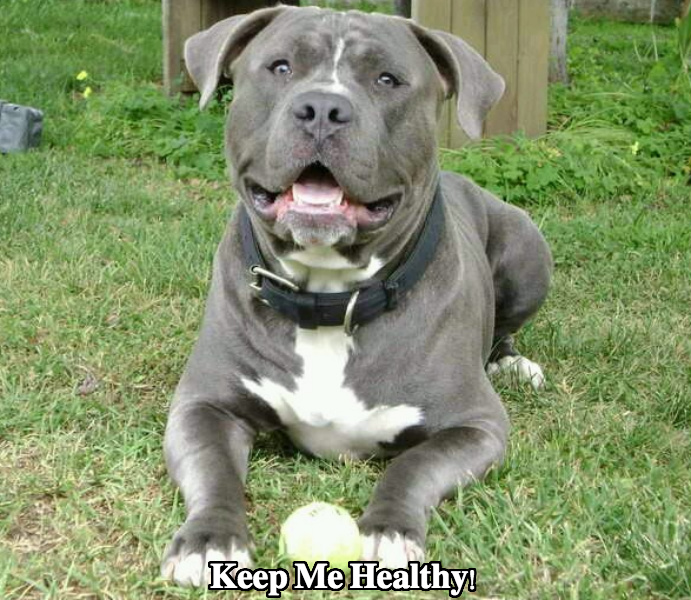
Experts reveal that genetic diseases are the most prevalent ones that plague this breed. These appear in dogs bred under harsh conditions. Sadly, they pass these illnesses to their offspring.
Like other dogs, the Blue may have skin diseases. It’s advisable to get a veterinarian to asses your pet for such problems.
Degenerative diseases are frightening and trouble many terrier-type dogs. Since the Blue is part-terrier, it may inherit these conditions.
Dietary deficiencies are common among Pitbulls. They are a result of poor nutrient absorption or a lack of trace elements. Fungal infections are common as well.
a. Common Health Conditions in Blue Pitbulls
i. Patella Luxation
First is Patella Luxation, a term which refers to a dislocated kneecap. This situation occurs when it moves out of place. It may also seize.
Vets usually prescribe surgery, but this is a painful option. Too much running may trigger this malady.
ii. Hip Dysplasia
Hip dysplasia occurs when the femur, or thigh bone, doesn’t fit into the joint socket. A dislocated thigh bone can cause pain and lameness. It’s one of the most prevalent canine diseases, and it troubles many dogs.
iii. Cleft Lip
A cleft lip is a malformation of the dog’s palate. The severity of the condition can range from mild to severe.
At its least troubling, it’s a cosmetic problem. It can also cause the Blue quite a bit of suffering. Note that you should not breed a blue with a cleft lip.
iv. Atopy
Atopy refers to the skin’s reaction to allergens such as pollen, dust, dandruff, or feathers. It causes a dog to scratch, and therefore, damage its skin. Hair loss may occur as well.
v. Demodicosis
This skin disease is the handiwork of the Demodex Canis mite. This pest troubles all dogs, to a greater or lesser extent. Hereditary conditions may exacerbate the situation.
vi. Hypothyroidism
Experts attribute hypothyroidism to a malfunctioning of the thyroid gland. It appears as dog ages, but could also be present in puppyhood. Puppies with Hypothyroidism will pass on early. The dog will experience general decline and cardiovascular problems.
vii. Ichthyosis
This condition causes a dog’s footpads to thicken and look oily. Ichthyosis isn’t merely cosmetic; in many cases, it causes so much pain that a vet has to euthanize the suffering animal. A dog can inherit this disease from its parents.
viii. Zinc-responsive dermatosis
This condition, simply put, is a lack of zinc. It causes a crust to form on the dog’s skin. The skin may itch and peel as well. Your Blue Pitbull may also lose hair around the eyes and nose. Zinc supplements can prevent the deficiency.
Ix. Fungosis
Short-haired dogs like the Blue Pitbull may experience fungal infections if they live in humid areas. Your vet will suggest treatment depending on the type of fungus that’s growing.
b. Ways to prevent Blue Nose Pitbull health conditions
I. Understand the breed
Know the health issues that a dog is predisposed to before buying it. For example, Blues will tend to develop the conditions outlined above.
ii. Spot changes in behavior
A dog that’s sick will behave queerly. Does your Blue whine without reason? It may be time to bring it to the vet. It’s better to treat the problem early than to let it exacerb1ate.
iii. Grooming
Regular cleaning of your dog’s ears will reduce the instances of ear-related diseases. Bathing your pet will lessen the chances of skin diseases. Clean your pet’s eyes to reduce the chances of eye diseases like Entropion or Cherry Eye.
iv. Keep up with medication
Without a doubt, medical care, whether for humans or pets, is expensive. However, making sure that your pet takes its dication regularly will lessen the need for expensive treatment.
v. Spay your pet
Neutering prevents not only unwanted pregnancies but also illnesses. Speak with your vet about sterilization to ensure your pet’s long-term health.
vi. Get your pet to drink
Make sure that your Pitbull drinks enough water. Your pet will drink less as it ages. To encourage it to drink, place water bowls in easy-to-reach areas. It’s also wise to bring water with you on long walks.
vii. Watch your pet’s weight
Blues tend to become a bit hefty if you don’t watch their weight. The advice in the section on stopping annoying behaviors will show you how to prevent overfeeding. Exercise your pet regularly as well; take it out for regular walks or trips to dog runs.
9. Blue Nose Pitbull Diet and nutrition
What should you consider when feeding your Pitbull?
Pitbulls aren’t picky eaters. Many would gulp anything that you put in front of them. Owners need to understand that Pitbulls, like other dogs, have nutritional requirements.
a. Ideal Body Weight
Breeders created Pitbulls to be resilient and look muscular. Adults weigh about 60 pounds. Proper nutrition will ensure that it doesn’t have health issues.
Pitbulls are prone to obesity, so its wise to put some thought into feeding yours. You’ll have to know how much to feed yours to sustain its energy.
You will know that your Pitbull is at an optimal weight if you have a helicopter view of its abdominal tuck. You should be able to see its ribs and waist as well. There shouldn’t be excess fat covering it either.
b. Feeding routines
Pitbulls are more likely than other dogs to overeat since they aren’t picky eaters. While this is a relief, it means that you cannot grant them free access to food. You should develop a feeding routine and stick to it.
Free feeding isn’t beneficial for Pitbulls because they won’t get the right amount of nutrition. Stick to feeding your pet a few times a day instead. Pitbull should eat between 1.5 and 2.5 cups of food.
Remember that Pitbulls are much like kids. They will not eat their main meals if you offer too many treats. It can result in overeating. Measure your dog’s food intake to prevent obesity.
c. Diet
The Pitbull diet should have a relatively high amount of protein – about 35 to 40%. You should pay attention to the components of the food. The quantity and quality of the food vary according to its manufacturer.
Its vital that dog food has top-quality meat. 70% of its protein should come from premium meat cuts. Make sure that it doesn’t contain corn, peanuts or grain. Do read labels.
Pitbulls thrive on a wet food diet, but you can feed it semi-moist food. Make sure that it contains high-quality meat as Pitbulls need protein for energy. A lack of protein may prevent it from getting the nutrition it needs.
The raw food diet is a controversial, but viable option. Pet owners may refrain from feeing their pets uncooked food; they fear that it may bring out aggressive tendencies. However, it is beneficial for your pet’s overall health. Fresh, whole foods promote healthy skin and coat as well. You will also see improvements in your Pitbull’s digestion.
Should you decide to put your Pitbull on a raw food diet, make sure that it contains meat. Protein sources are best for Pitbulls with heart, kidney and liver problems.
d. Supplements
Whole foods are optimal, but dogs need vitamins and minerals as well. Your dog may prescribe them if your pet has a vitamin deficiency.
While protein is the essential nutrient for a mischievous Pitbull, do bear in mind that it needs other nutrients. Your pet won’t have much energy without it.
10. Obedience training for Blue Nose Pitbulls
Your Pitbull has a dominant streak, so it’s important to let it know who the pack leader is. You must teach it a few basic obedience commands to tell it that you are in charge.
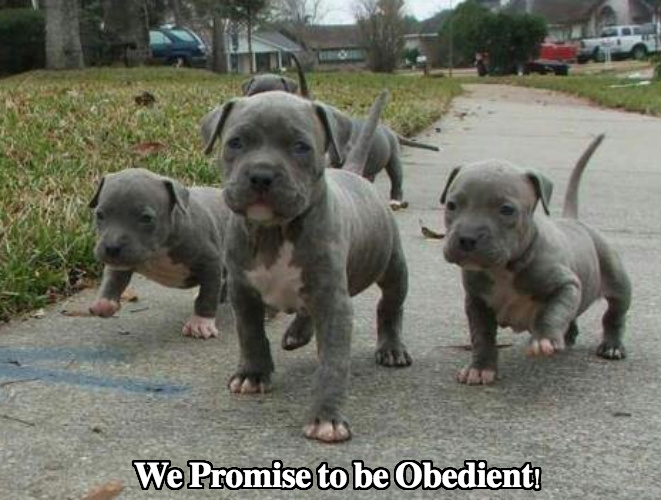
a. Watch Me
Before your dog can learn other commands, it must learn to watch you. Keep eye contact with your pet and hold a nice-smelling treat in your hand. Move it up to your pet’s face. As he looks at the goodie, give the command, ‘watch me.’ If it gazes at you, give it the treat as a reward.
b. Sit
This command is usually the first that all dogs learn. It keeps your pet in place in dangerous situations.
To get your pet to sit, hold a treat in front of its nose. Move it up so that it will follow. Since your dog won’t be able to get the treat, it will lower its bottom naturally. When it’s in this position, say ‘sit,’ and give it the goodie. Repeat this exercise until your pet masters its response to the instruction.
c. Stay
Again, this instruction keeps your feisty Pitbull in place.
Before it learns to stay, it must lear the ‘sit,’ command. First, get your pet to sit. Then, hold up your palm and say ‘stay.’ Take a few steps back. Reward your pet if it doesn’t follow you.
d. Down
The down command can be a difficult one for your Pitbull to learn. It’s an Alpha dog and may find the submissive posture hard to master.
To teach’down,’ find a particularly nice-smelling treat and hold it in a closed fist. Move it close to your pet’s nose. When it smells the treat, move your hand close to the ground and get your pet to follow this movement. When it is in the submissive pose, say ‘down’ and give your pet the treat.
e. Heel
Teach the heal command by putting the leash on your right hand and pulling it on your left. Do this as you are walking. At some point, tell your pet to sit. Hold a treat in your left hand and give the ‘heel’ command in a happy voice.
Take a few steps and keep the treat by your side. When you pause, move the treat up. The dog will sit. Praise it and let it know that it has followed your instruction well.
f. Come
This command also keeps your pet safe in dangerous situations.
Put a collar or a leash on your pet. Walk some distance away from it and say ‘come,’ gently pulling the lead toward you. Give it the treat when it arrives. Repeat this exercise until your pet learns to come when called.
g. Off
You will want your pet to keep its paws off objects such as food. Put your fist against your pet’s face so that it can smell and lick it.
Since the goodie is in your clenched fist, your dog cannot get to it. Let your pet have the treat just as it’s about to give up.
Repetition is the key to getting your Blue to master this command. It is useful for getting your pet off furniture, people, or pets.
h. Drop It and Take It
These commands will teach your Blue to grab objects when instructed and to leave them when necessary.
Teach this command by holding the object that the dog values in your hand. It will prompt your Blue to follow you and struggle to grab it.
When your Blue opens its mouth to catch the item, give the command ‘take it.’ Your dog will associate the phrase with a reward. As it continues playing with the object, offer something similar.
The dog will drop the first object instinctively and reach or the second item. The moment it does this, give the command ‘drop it.’ As it reaches for the second item, give the command ‘take it.’
Repeat this exercise until your pet masters the command.
i. Out
This command is useful when you want your pet to abandon items that you don’t want it to have in its mouth.
Teach it by letting your pet hold one of its favorite toys in its mouth. At the same time, grab the toy and keep it close to you.
Your Pitbull will initially insist on keeping the toy for itself. As you continue pulling it towards you, it will let go. When this happens, offer the toy back to the dog and repeat the exercise. Do this until your pet masters the command.
j. Leave it
You will want your pet to know when to grab treats. Teach it the ‘leave it’ command.
Have a treat in both hands. Put one of your hands in front of your pet’s face and allow it to smell the goodie. Then, tell your pet to ‘leave it.’
Your pet will initially insist on having the treat. At this point, offer it the goodie in your closed hand. Repeat this exercise your pet knows how to leave it alone. You can show it some affection as it reaches for the treat.
k. Crate
Your Pitbull will need to know when its time for bed. Leash your pet. Hold the leash in one hand and a goodie in the other.
Guide your pet to the crate, bed or blanket where you want it to sleep. When it settles down, give it the treat and say ‘place,’ ‘sleep,’ or ‘crate.’ It doesn’t matter what word you use, as long as you do so consistently.
Repeat this exercise until your pet understands the command. To release it, say ‘break.’
l. Stand
You will need to use this command when your veterinarian wants to examine your Pitbull. The sit command is a prerequisite for learning this one.
Get your Pitbull to sit. Have a treat in your hand, and put it close to your pet’s nose. Move your hand forward, then down. The dog will follow the movement.
At this point, move your hand forward so that your pet is in a standing position. Give the command ‘stand’ and offer it the treat as a reward. Repeat this exercise until your Pitbull masters it.
m. No
You will want your Pitbull to stop improper behaviors. It will need to respond to ‘no.’
Keep your pet leashed as you walk toward a treat. When your pet tries to grab it, say ‘no’ and pull the dog towards you. As it comes toward you, give it another treat that you are holding in your hand. Say ‘yes’ and reward it with some affection. Repeat this exercise until your pet masters it.
n. Settle Down
Your pet will need to learn this command if it’s in public areas. It’s also necessary for reminding your pet not to jump up on others.
To teach it, hold a clicker with one hand and a treat in the other. Pull on the clicker and guide the dog into its crate. As soon as it into its sleeping area, say settle down and give it the treat.
Release the dog by saying okay, and call it back to you. Repeat the exercise until your pet masters the command.
11. Games to play with your Blue Nose Pitbull
Pitbulls are full of energy and enjoy vigorous games. Here are a few that your pet will love.
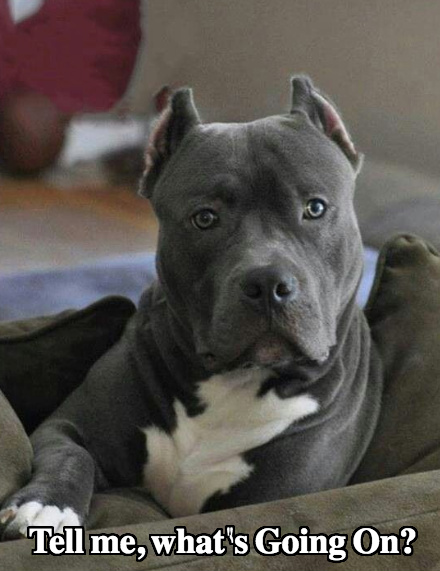
a. Tug
First on this list is Tug. Some dog owners aren’t in favor of getting into friendly tussles with their pets, particularly Pitbulls, because they fear that doing so may cause aggression.
This game doesn’t turn your pet into a predator if played correctly. It is an opportunity for you teach it other basic commands. such as ‘wait’ or ‘leave it.’ He can also learn to drop the object that you are tugging.
b. Which ball
This game provides plenty of mental stimulation. Grab two balls, preferably of different colors. You could also place a marking on one. Rub your scent on one, and leave the other be.
Then, take your Blue outside. Before doing so, hide the balls in the same area. Your pet should bring back the ball with your smell on it.
c. Fetch and Hide
This fun combination of the games of Fetch and Hide will get your Blue going for hours. Play this game outside, where there is more room for both of you.
Take your dog’s favorite toy for the game of fetch. Throw it as far as you can. While your pet is running after the ball, find a place to hide. Let your pet discover your scent, and you.
d. Jump and snag
The Pitbull is known for being agile, so now is the time to test its mobility. Throw a toy or stick, and see how high it can jump. Play this game outside if you have limited space indoors.
e. The Name Game
Get a few stuffed animals, preferably those with monosyllabic names like ‘dog’ or ‘cat.’ Focus on a few objects first.
Toss each item and say its name. Your Pitbull will learn the words. Then, throw two objects and get your pet to bring the one you named one back to you.
f. Treasure Hunt
The Pitbull is intelligent and needs lots of mental stimulation. Get it to find hidden treasure. A treasure hunt is an excellent way to stimulate its brain and its senses.
Hide toys or treats in places that aren’t obvious. Put your pet in a sit or stay position as you do this. Call your pet when you are ready, and watch it have some fun.
Once your Blue has gotten used to the game, you can increase its difficulty. Set up cardboard boxes and place a toy or treat under only one of them. Let your Pitbull investigate each of them until it finds the treat.
g. Hide and Seek
You’ll need to play this with two people. While one keeps your pet in a sit-stay position, the other hides treat. Give your pet the cue to find the items when you are ready.
h. Ring stackers
This game teaches your pet eye-to-paw coordination. The objective of this game, of course, is to stack rings. Use wooden ones as your pet will chew on them quite a bit. The ring size you should choose depends on the flexibility of your pet’s mouth.
i. Shell game
If your pet likes the occasional gamble, this game will suit it. It’ll adore this game because of the treats involved.
Take opaque cups and turn them over. Place a treat under one of them and get your pet to overturn it. Do this until your Pitbull understands the game.
Give it the treat if it chooses the correct cup. If it doesn’t make the right choice, show it the right one, but don’t let it have the treat. Keep doing this until your pet masters the game.
Raise the stakes once your pet gets a grasp of the game. Place a treat under one of the cups and slide them so that they switch places. The cup with the goodie should be to your right.
A friend or family member should be holding your pet all this time. Get him or her to release your pet to find the goodie. If your pet is unsuccessful, let it see the right cup, but don’t allow it to have the treat. Do this until your pet realizes that you are switching places.
12. Managing annoying Blue Nose Pitbull behaviors
Like each of us, pets aren’t perfect. Your Blue Pitbull will have annoying behaviors which you will need to manage. Here’s are a list of annoying traits which your pet may exhibit occasionally, and how to deal with them.

a. Barking
The first trait is barking, which tops the list of behaviors that trouble owners. It’s annoying to both you and your neighbors, and you don’t want them knocking on your door.
Note that you don’t want your pet to stop barking. It has its uses; you need your dog to tell you when something strange is afoot. However, you do want it to end at the right times.
Find out what makes your pet bark, and remove the stimuli. If you know that it’s the postman that your dog is particularly fond of, take it away when he arrives. If your dog desires a reaction from you, ignore it. Cover its mouth and say ‘no speak.’
b. Jumping
Dogs jump because they are excited to see their owners after a long day. As adorable as this behavior is, it has to stop. You don’t want your pet endangering small children who come to your door or strike fear into the heart of someone who hasn’t interacted with a dog before.
You don’t want to scold your pet because it has good intentions. However, you do want it to know that jumping isn’t acceptable behavior. Ignore your pet when it jumps. Wait until it is calm and submissive before giving it affection.
c. Chasing
Some dogs love rushing after moving objects. Chasing almost always happens when an owner accidentally leaves the front door open.
To deal with this behavior, make sure that your pet knows the basic obedience commands, ‘sit,’ ‘stay,’ and ‘come.’ Once your pet masters these commands put your dog on a lead and begin outdoor training. Reward it each time you say ‘stop,’ and it doesn’t chase the object. Microchipping your pet may help as well.
d. Chewing
Pitbulls love to chew. You don’t want to keep replacing your favorite slippers.
Consistency is the key to eliminating this behavior. Remove the object your dog chew every time you spot it. Replace it with a safe chew toy instead.
e. Begging
Dogs love human food because it tastes much better than their own. The behavior is cute, but annoying after a time.
Stop begging behavior by ignoring it. Don’t encourage your dog, even by saying ‘no.’ Acknowledging it tells it that begging is acceptable. Also, feed your pet at the same time you eat. Your pet will be too occupied eating its food to bother about yours.
f. Digging
No one wants to come home to find their flower pots or beds upset. Digging is upsetting behavior, and Pitbulls have a propensity for it.
To limit it, seclude your pet in an area in your garden where you won’t mind a little mess. Give your pet a sandbox where it can be as messy as it wishes.
g. Gulping
Pitbulls have a propensity for gulping, owing to an Alpha streak that compels them to get food ahead of their pack members.
Gulping is a little offensive, and dangerous. To stop your pet from wolfing its food too quickly, use specially designed bowls that limit how much food it can swallow. Ask your pet store for recommendations.
h. Nipping
Nipping seems affectionate and cute. However, it can be a precursor for aggressive behavior.
Yelp loudly to stop your Pitbull puppy from mouthing you. Then, remove yourself from interacting with it. Your pet will eventually learn that nipping isn’t acceptable.
i. Aggression
Aggressive behavior is a sign of dominance or a dog’s desire to protect its human. You can get a trainer to recondition an aggressive dog, but you can do your part to limit the problem. As you are aware, some Blues may have this behavior.
Stay calm when other dogs are present, and keep your pet leashed. Always avoid situations when they may be a conflict. Never yell or run, as doing these will cause even more aggressive behavior.
Socialization is key to stopping aggression, whether it is towards pets or people. Puppies that grow up by themselves and never interacting with others tend to develop aggression borne out of fear.
ii. Separation Anxiety
Separation anxiety is a sign of a strong bond between a family pet and its owner. However, it is still unhealthy behavior. It may lead to destructive behaviors like chewing or digging.
If your pet struggles with this, leave it for short periods at a time. However, lengthen them as it becomes accustomed to you being away.
Don’t make a fuss when you are about to leave your home. You want to assure your pet that you will return. Play soft music to listen to while it waits.
13. Common myths about Blue Nose Pitbulls
The Blue Pitbull, like its cousins, has a fearsome outlook. The propensity for those which have not been well-raised to display aggression has led people to develop misconceptions about the breed. Here are a few myths that we should debunk.
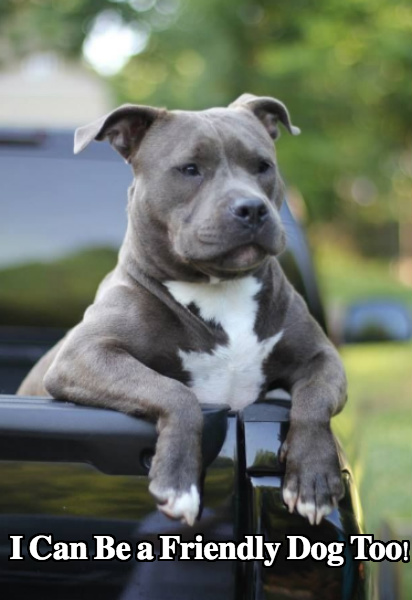
a. Banning Blues and other Pitbulls increases peoples’ safety.
Bans on ‘potentially aggressive’ dog breeds such as the Pitbull or Camaro are breed-specific legislation. They don’t enhance the safety of communities.
It’s nearly impossible to identify a dog. The police rely on witnesses to recognize an attacking dog’s breed, but not everyone is a canine expert. Research shows that even veterinarians can’t make accurate identifications.
Furthermore, such legislation is expensive and doesn’t result in any benefits for public safety.
b. Pitbulls are vicious by nature.
Debunk this myth. Like people, Blues, and other Pitbulls have individual personalities or ‘dogsanalities.’
The term Pitbull doesn’t refer to a specific dog breed. It is a class of terriers that have block-shaped heads because of their bulldog genes. Though a Blue or other Pitbull may resemble a terrier or bulldog, it may or may not share a genetic relationship with it.
What this means is that Pitbulls don’t haven’t inherent aggression; it isn’ right to stereotype a dog based on its name or appearance.
c.Breeders developed Pitbulls to fight.
Some Pitbulls do fight, so this statement reflects some degree of reality. Breeders bred Pitbulls for dogfights in days of old, and some errant ones still do so illegally.
That said, people don’t breed Pitbulls for specific purposes. Most make excellent, loving pets which get along superbly with children.
d. Pitbulls have locked jaws
Nothing could be further from the truth. Pitbulls don’t have terrifying, locked jaws. They have muzzles like every other dog. Their skulls are somewhat large, but this factor doesn’t increase their propensity to bite.
e. You should keep your Blue away from your child.
On the contrary, you could train your Blue Pitbull to look after your child. Some Pitbulls are incredible nannies. Of course, not all Pitbulls are up to the task. This statement is a reflection of every other dog breed.
To keep your child safe around your pet, supervise him during playtime. Excessive teasing may prompt aggression borne out of self-defense.
f..Pitbulls are animal aggressive.
Some Pitbulls get along better with animals than others. Like all dogs, your Blue will get along famously with a tiny Chihuahua if you socialize it well.
The story of Joanie, the female Pitbull, proves this point. Authorities found her carrying the severely injured Chachi the Chihuahua in her mouth. The two are best buds; their owner adopted them both.
g. Fighting Pitbulls can never become pets.
Many people, including animal rescue groups, shared this belief until recently. Pitbulls owned by experienced owner Michael Vick proved otherwise.
Twenty-two of his dogs survived severe abuse. The Best Friends Animal Society rescued these dogs, and they have found loving families. These canines are testament how resilient Pitbulls, and other dogs, are.
h. Pitbulls eventually turn on their owners.
It is rare for a Pitbull, or any dog, to turn on its owner, and statistics prove as much. Dog attacks kill fewer than 30 people per year.
According to data published in the Journal of the American Veterinarian Medical Association, people could only identify a dog’s breed in 45 incidents.
That said, non-fatal dog bites are common. The Center for Disease Control reports that there are 4.5 million dog bites in the United States every year. Some media reports blame the Pitbull, but there is no evidence to prove that it is responsible.
i. Pitbulls are the only banned breed
Pitbulls aren’t the only breed of dog not allowed in apartment complexes. Pasar Camaros, Rottweilers, and in some cases, German Shepherds can’t live in apartments.
Communities banned other dog breeds in the late 19th century. The residents of New Jersey banned the Spitz in 1878. Massachusetts banned the Bloodhound a few years after that.
j. Dogs are solely at fault for dog bites.
Dog bites are the fault of reckless dog owners as they are the dogs themselves. Governments can help to reduce the instances of dog bites by holding dog owners accountable. They should follow tethering laws, i.e., they shouldn’t leave the dogs tethered for too long. They should also spay their pets.
In conclusion, the Blue Pitbull isn’t as scary as it seems. While some Pitbulls tends towards aggression, most are responsive, fun-loving animals given proper socialization and training. This dog requires care and commitment, so prepare for both before adopting it. Know all there is to know about its feeding, grooming, and breeding requirements.
